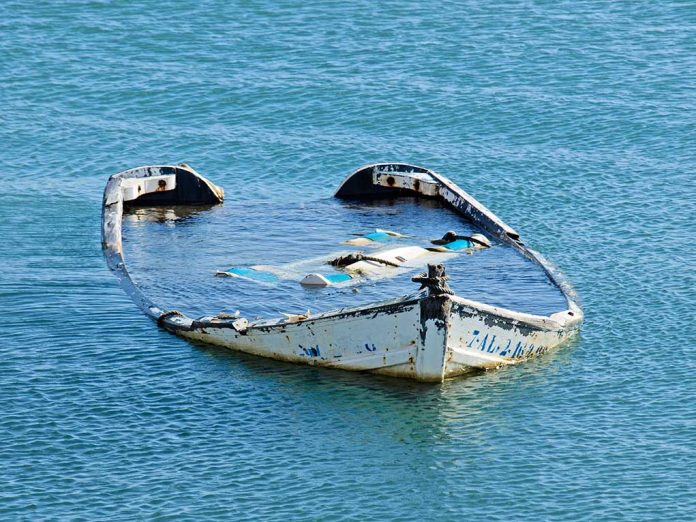
A cargo ship transporting 3,000 vehicles, including 800 electric cars with volatile lithium-ion batteries, has sunk to the depths of the Pacific Ocean after a devastating fire forced its crew to abandon ship, highlighting the escalating danger of maritime EV transport.
Key Takeaways
- The Morning Midas cargo ship sank in the Pacific after a fire erupted on a deck carrying approximately 800 electric vehicles, forcing all 22 crew members to evacuate
- EV fires are exceptionally difficult to extinguish, requiring up to 8,000 gallons of water to cool lithium-ion batteries and prevent dangerous “thermal runaway” reactions
- This incident mirrors the 2022 Felicity Ace disaster, demonstrating a concerning pattern of EV-related maritime accidents
- Zodiac Maritime has deployed pollution control equipment and is collaborating with the U.S. Coast Guard to manage the environmental impact
- The disaster raises serious questions about current safety protocols for transporting the growing number of electric vehicles worldwide
Disaster in the Pacific
The Morning Midas, a 600-foot cargo vessel built in 2006, departed from China on May 26 with approximately 3,000 cars destined for Mexico. Disaster struck on June 3 when crew members spotted smoke emanating from a deck carrying about 800 electric vehicles. Despite efforts to control the spreading flames, the fire proved unstoppable, forcing all 22 crew members to abandon ship after a rescue operation by the U.S. Coast Guard. The 46,800-ton vessel had been adrift for weeks before finally succumbing to fire damage and severe weather conditions, sending thousands of vehicles to the ocean floor.
“Smoke was first seen coming from a deck on the Morning Midas that was carrying about 800 EVs, the ship’s manager Zodiac Maritime said in a statement,” said Zodiac Maritime.
The ship’s owner, Zodiac Maritime, has moved quickly to address potential environmental damage, deploying salvage tugs equipped with pollution control equipment to monitor for contaminants and debris. A specialized pollution response vessel is currently en route to the location as an additional precautionary measure. The company is working closely with the U.S. Coast Guard and Resolve Marine to coordinate emergency response efforts in the international waters where the ship went down, highlighting the complex jurisdictional challenges that accompany maritime disasters.
The EV Fire Danger
This catastrophe underscores the growing concern about transporting electric vehicles and their volatile lithium-ion batteries. Unlike conventional vehicle fires, EV fires present unique challenges that make them extraordinarily difficult to extinguish. The batteries can experience “thermal runaway,” a dangerous chain reaction where increasing temperature triggers additional chemical reactions, creating a self-perpetuating fire that can burn for days. Maritime environments compound these dangers due to limited ventilation and restricted firefighting capabilities aboard cargo vessels.
Extinguishing EV fires requires massive quantities of water—up to 8,000 gallons—to cool the batteries. This volume far exceeds the firefighting capacity of most cargo vessels. Additionally, lithium-ion batteries release toxic fumes when burning, creating additional hazards for crew members attempting to combat these blazes. The Morning Midas incident demonstrates how quickly such fires can escalate beyond control, forcing complete abandonment of multi-million-dollar vessels and cargo.
A Pattern of Disasters
The Morning Midas sinking bears striking similarities to the February 2022 Felicity Ace disaster, when another car carrier transporting approximately 4,000 vehicles—including numerous EVs—caught fire and sank in the Atlantic. That incident resulted in an estimated $400 million in losses. These back-to-back disasters establish a concerning pattern that highlights inadequate safety protocols for maritime EV transport at a time when electric vehicle shipments are rapidly increasing due to government mandates and shifting market demands.
The shipping industry has begun implementing enhanced safety measures to manage these emerging risks. In 2024, a maritime safety group published comprehensive guidelines specifically addressing fire prevention and response on car-carrying vessels. However, the Morning Midas incident proves these measures remain insufficient to protect against the unique dangers posed by mass EV transport. As President Trump’s administration has consistently warned, the rush toward electrification brings significant safety challenges that require more thorough risk assessment and mitigation strategies.
Environmental and Economic Impact
Beyond the immediate loss of the vessel and its cargo, this disaster raises serious environmental concerns. The 3,000 vehicles now resting on the ocean floor contain numerous toxic materials including oils, fuels, and battery chemicals that could potentially leak into the marine ecosystem. The lithium-ion batteries pose particular environmental hazards as they deteriorate in the saltwater environment. The economic impact extends beyond the value of the ship and its cargo to include disruptions in the automotive supply chain, particularly for Chinese manufacturers who produced most of the vehicles onboard.
As the maritime industry grapples with the increasing frequency of these EV-related disasters, insurance costs for transporting electric vehicles will likely rise significantly. This will ultimately increase consumer prices and potentially slow the adoption of electric vehicles, highlighting the hidden costs of the green energy transition. The Morning Midas incident serves as a stark reminder that technological transitions often bring unforeseen challenges that require comprehensive safety solutions before widespread implementation.









